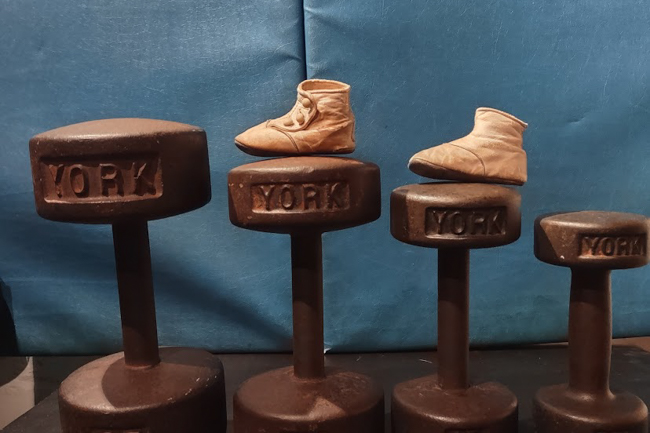Baby Steps Can Begin a Life-Changing Climb

My dad had a pretty set routine throughout my childhood. He would come home after a hard day’s work, fix himself a dry martini, proceed to the den with a newspaper tucked under his arm, turn on the television to the local news, and resign to his familiar spot on the sofa.
He’d snap the newspaper open into proper reading position and, as soon as his eyes scanned the first few words, his head would slowly tilt back as he drifted into a state of unconsciousness.
Though he was never formally diagnosed with narcolepsy, he sure could turn from alert and communicative to out cold on a dime. He wouldn’t wake up when you called his name if a smoke alarm went off or if a car backfired, but if you changed the channel he would suddenly spring up and yell, “What are you doing?!”
Through trial and error my sister and I eventually figured out how to breach his keen auditory tripwire. We would ever so gradually lower the volume in imperceptible increments, change the channel, and then reverse the process, gradually raising the volume to its original level. It was the perfect victimless crime, other than my dad being slightly less informed on a subliminal level.
Incremental change is good, and so is incremental progress. Most of us don’t do very well with about-face, abrupt change. Old habits die hard and are often our default mode when trying to do too much too soon. Evolution is a gradual process with a distant finish line.
I’ve trained a lot of people over the years and fondly recall my fair share of success stories, but in truth it wasn’t all beer and skittles with positive results. And although there wasn’t one specific recipe for failure, there was a particular category of client that usually didn’t end very well: the spouse buying workout sessions for their partner as a gift.
There are plenty of important reasons to exercise, but this was almost always about cosmetic exercise goals for their mate. Reducing the risk factors for cardiovascular disease never entered the conversation; it was invariably about frumpy aesthetics as husbands and wives demeaned each other in front of me during our initial meeting. Nothing says ‘I love you’ like “I find you less physically attractive.”
Even I know that cosmetic surgery coupons, self-improvement webinar links, and unsolicited workouts do not put you in good standing with your significant other.
My prospective customers were not motivated. They felt ambushed, and there’s nothing like trying to work with a resistant audience. Change has to come from within; you can lead a husband to dumbbells, but you can’t make him lift. Certain people need to be eased into healthy lifestyle changes, not have it rammed down their throats.
I’ve always felt that having my athletes buy into my program is an important piece of the success puzzle. When they understand why you’re having them do a certain drill it motivates their work effort in such a way that goes beyond a general desire to improve.
‘Slow and steady’ is a tough sell in our culture of instant gratification. With weight loss in particular, people who are on the right path to success plateau at some point, become frustrated, and quit. Improvement is never linear over the long-term; it should be looked at over the course of a year, not at how much more weight was lost in Week 3 compared to Week 5.
Meaningful progress on a graph might look something like a staircase plot – a period of steep improvement, a subsequent stage of settling, then another surge, followed by the unwanted slowdown, and so on. From start to finish the growth is dramatic, though you may get discouraged in some moments along the way.
I’ve never been much of a Lance Armstrong fan, even when he was a media darling, but a few of his sound bites have stuck with me. And to be fair, a sociopathic cheat can still offer up some profound wisdom.
When he was a shell of himself, having literally and figuratively gotten back on the bicycle, he started out pedaling around the neighborhood on his automobile-priced bike getting crushed by the local 8-year-olds on their modest little bikes. He then told himself, “Next week you have to keep up with the 8-year-olds.” Once he caught the 8-year-olds, his ego took another hit as the soccer moms flew by him and it was on to the next goal of being able to hang with the soccer moms. He eventually got back into pre-cancer shape by setting these small goals and adjusting accordingly as he moved forward.
I love this account of his recovery on so many different levels. A world-class athlete being outperformed by little snotty kids is quite humbling, but he worked with it rather than giving in to shame. He used an advisable progression to regain his pre-illness status.
Change needs to be finessed, not forced.
To paraphrase Mark Twain, “Habit is not to be flung out the window, but coaxed downstairs one step at a time.” The reverse must also hold some water: that improvement is a one-step-at-a-time ascending journey, not an elevator ride to your destination.
Slow and steady may win the race, but it also delivers success if you have the patience and determination.
— Certified strength and conditioning coach Norman Meltzer, the owner/operator of MW Strength and Conditioning in New Bedford, was known during his competitive weightlifting career as “the Muscleless Wonder” for his lean, mean physique lacking in the traditional bulk associated with strength training. Meltzer’s experience and knowledge has helped pro, college, and high school athletes and teams, and even regular people improve their strength and performance.
Schvitz’n with Norm
Article originally published in The Wanderer
By Norm Meltzer

Norm Meltzer aka The Muscle-less Wonder
